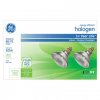- Messages
- 725
Outdoor Flood bulbs:
I have been using low wattage, Par38 outdoor halogen flood bulbs for my basking tegus (and monitors too!) for a very long time. They produce high heat and the low watts helps save on electricity bills and does not dry out the air as much as high wattages do so it helps maintain proper humidity levels. For example, when using Zoo Med/Exo-terra or other reptile brand heat and basking bulbs you would have to use very high watts such as 150 or higher to achieve high basking temps, whereas with the outdoor flood bulbs you can do a cluster of 50-60watts. In my 8x3x3 and 8x4x4 enclosures I have a cluster of 2-3, 60 watt bulbs to create a surface temp of 130-135f degrees for my adults. Any smaller sized tegus can handle 1 or 2 bulbs. The idea of cluster lighting is to give an even amount of heat from their snout to vent to effectively heat their body to optimal core temp. As the animal grows you can add another bulb to spread out the beam of heat/light. You will have to play around with the different watts (while staying low! No more than a 90watt for each bulb should be needed) as wattage depends on how many bulbs your are offering as well as the height from the basking surface and what the surface is. Slate will heat up warmer than porous rocks such as a cinder block or paving stone. Plywood heats up faster but doesn’t retain the heat as long after the lights have gone off. Remember you will need a temp gun to properly measure surface temperature.
I have also found that the outdoor flood bulbs last longer than typical reptile heat bulbs and if water from your mister hits them, they will not explode. You can find them at walmart, any home improvement store, hardware stores and even some grocery stores have them in the household isle so they are readily available. I prefer to use GE, Phillips, or Sylvania brands as I find they last longer and produce more heat than some of the off-brands. Its important to get the outdoor and floods. Not indoor and not spot bulbs. You want Par38’s as that is the bulb size, any smaller produces too narrow of a stream of light/heat. These bulbs are for heat only, and do not produce UV. If you want to offer UV then you would need a separate uv source such as a florescent ZooMed ReptiSun.
I have been using low wattage, Par38 outdoor halogen flood bulbs for my basking tegus (and monitors too!) for a very long time. They produce high heat and the low watts helps save on electricity bills and does not dry out the air as much as high wattages do so it helps maintain proper humidity levels. For example, when using Zoo Med/Exo-terra or other reptile brand heat and basking bulbs you would have to use very high watts such as 150 or higher to achieve high basking temps, whereas with the outdoor flood bulbs you can do a cluster of 50-60watts. In my 8x3x3 and 8x4x4 enclosures I have a cluster of 2-3, 60 watt bulbs to create a surface temp of 130-135f degrees for my adults. Any smaller sized tegus can handle 1 or 2 bulbs. The idea of cluster lighting is to give an even amount of heat from their snout to vent to effectively heat their body to optimal core temp. As the animal grows you can add another bulb to spread out the beam of heat/light. You will have to play around with the different watts (while staying low! No more than a 90watt for each bulb should be needed) as wattage depends on how many bulbs your are offering as well as the height from the basking surface and what the surface is. Slate will heat up warmer than porous rocks such as a cinder block or paving stone. Plywood heats up faster but doesn’t retain the heat as long after the lights have gone off. Remember you will need a temp gun to properly measure surface temperature.
I have also found that the outdoor flood bulbs last longer than typical reptile heat bulbs and if water from your mister hits them, they will not explode. You can find them at walmart, any home improvement store, hardware stores and even some grocery stores have them in the household isle so they are readily available. I prefer to use GE, Phillips, or Sylvania brands as I find they last longer and produce more heat than some of the off-brands. Its important to get the outdoor and floods. Not indoor and not spot bulbs. You want Par38’s as that is the bulb size, any smaller produces too narrow of a stream of light/heat. These bulbs are for heat only, and do not produce UV. If you want to offer UV then you would need a separate uv source such as a florescent ZooMed ReptiSun.

